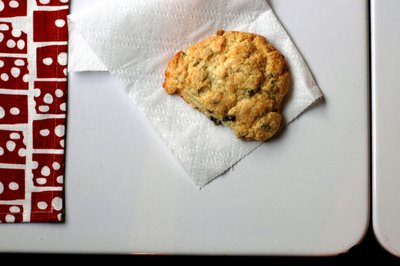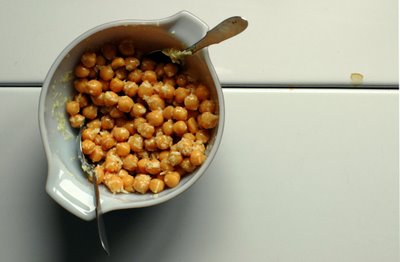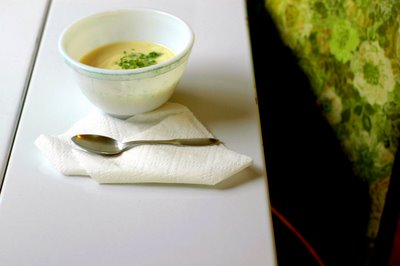Month: January 2007
The usual
I have this funny thing about recipes. When I find one that I like – for, oh, let’s say, lentil soup – I have a hard time trying others in the same genre. I will, of course, but in most cases, I would be just as happy to rest on my laurels and sit there, sipping that same lentil soup, until the end of time. This is not good behavior, I know, for someone who supposedly cares about cooking. I’m supposed to be some sort of happy mad scientist, a real free spirit, some sort of kitchen sprite with a spoon and a stand mixer and a relentless sense of curiosity. Sometimes I am. But most of the time, I’m not. I can’t help it. I’m loyal, and sentimental, and when something clicks with me, I want to keep it around. That goes not only for recipes, but also for beauty products, and men.
But about the recipes: take, for instance, my sister’s Scottish scones. I’ve written about them here before – twice, actually. In the whole wide, nubbly world of scones, they’re my very favorite. They’re the sort of thing that you’d eat, I imagine, before setting out for a brisk, rousing hike in the Scottish Highlands. Solid, tidy things, they have a dense, tight-woven crumb that tears apart into fat, flaky layers. They bear a close resemblance to a biscuit, but more delicate and dainty, with a flavor that’s more flour and less fat. Scones seem to run a spectrum these days: at one end sits the fluffy, muffinesque camp, and at the other, the sturdy, Old World, biscuit-like type. My sister’s rest delectably among the latter, which is just where I want them. Forever.
However, I do have a rather fat collection of cookbooks, not to mention an ever-growing accordion file of recipe clippings, and they demand my attention every now and then. They’re very annoying that way. You wouldn’t believe how pushy they are. They throw themselves at me. They lie next to my bed like flat, lazy dogs. They stretch and yawn all over my lap. And sometimes, like yesterday, they tell me about scone recipes that aren’t my sister’s. The nerve. I swear.
What’s worse is that I listened, and liked it.

This recipe isn’t replacing my sister’s quite yet, but
that’s only because I’m very, very stubborn. If my sister’s
scones are Scotland, these are Seattle – not only because
they were developed nearby, at
Macrina Bakery, but
also because they’re decidedly New World, made for a city with a
Space Needle. These
craggy, homespun beauties
have a thin, golden crust and a rich, cakey crumb that’s a
little like a muffin, but with more moxie. A twist on the
classic cream scone, they’re made without eggs or butter,
getting their body, richness, and flavor from a generous dose of
heavy cream instead. But what sets them apart from the standard
cream scone is a pair of electric beaters. This recipe calls for
cream that’s been whipped to the smallest of soft peaks,
yielding a dough that feels wonderfully light and airy,
like a cool, downy pillow. The dough rises and puffs as it bakes, making for an open,
tender crumb and, I have to say, a totally bang-up scone.
And if you’re not yet sold, I have three more words for you: currants and fennel seeds. They’re in there too. It’s an unusual pairing, I know, but trust me: the winey, wintry currant has never had such a sweet, fresh-faced companion as the fennel seed. And with all that cream, and that lovely crumb? These scones feel like winter and spring baked together in a convenient, hand-held shape – one that may well become the usual around here.
Cream Scones with Currants and Fennel Seeds
Adapted
from
Leslie Mackie’s Macrina Bakery and Café Cookbook
I don’t know about you, but when I think of fennel seeds, my mind doesn’t naturally leap to scones – nor, for that matter, to anything remotely of the sweet genre. This recipe, however, has me singing a different tune. Local baker Leslie Mackie is really onto something.
Be sure to use good, fragrant fennel seeds for this – not that bottle of stale ones (ahem) that’s been sitting at the back of the spice drawer for years. I used some wild fennel seeds sent to me last fall by a certain cookiecrumb, and they were delicious.
1 cup dried currants
1 tsp fennel seeds
3 ½ cups
unbleached all-purpose flour
¾ cup granulated sugar
2
Tbsp. baking powder
1 tsp salt
2 ½ cups heavy cream,
plus 1-2 Tbsp. for glazing
Preheat the oven to 350 degrees Fahrenheit, and line two baking sheets with parchment paper or silicone liners.
Place the currants in a small bowl, and cover them with warm water. Set them aside to plump for ten minutes; then drain.
Meanwhile, in a small skillet, toast the fennel seeds over medium heat for about 1 minute, until fragrant. Pour the seeds into a small dish – if you leave them in the pan, they could burn – and set aside to cool.
In a large bowl, whisk the flour, sugar, baking powder, and salt until thoroughly blended. Add the drained currants and fennel seeds, and stir to incorporate.
Pour 2 ½ cups of the cream into a medium bowl, and beat just until it begins to hold small, soft peaks. It should not be stiff. Using a rubber spatula, gently fold half of the whipped cream into the dry ingredients, and then fold in the second half. When the dry ingredients are absorbed, turn the shaggy dough out onto a floured surface. Coat your hands well with flour, and gently work the dough – pressing and massaging and gathering, but not really kneading – into a rough ball. Do not overwork it: you want it to just come together. Press the dough into a large, thick round, and cut it in half. Form the halves into two smaller rounds, each about 1 inch thick – they need not be pretty, nor particularly even – and cut them into 6 triangles each. Gently transfer the scones onto the prepared baking sheets, and brush their tops with cream.
Bake the scones for 20-25 minutes, rotating the pans halfway through, until pale golden. Serve warm or at room temperature.
Note: These scones – and all scones, for that matter – freeze beautifully in an airtight container or bag. Allow them to thaw to room temperature before reheating in a low oven.
Yield: 12 scones
Brown bag it

One day a few weeks ago, entirely without prompting, Brandon packed me a lunch for work. Just like that. I opened the fridge, and there it was: a Tupperware containing one of his trademark concoctions, soba noodles with a peanut-citrus sauce, with my name on it. “Oh yeah,” he said nonchalantly, “I thought you might like some for your lunch tomorrow.” With no explanation, just like that, he packed my lunch. I may be crazy, but it made me feel a little faint. I guess the conventional way to woo a woman would involve roses, or chocolates in a frilly box, or fancy dinners set to a soundtrack of Marvin Gaye. But personally, I think “make her a brown-bag lunch”…
Read moreMy daily bouchon

You guys are to be commended. It takes a very kind, optimistic crowd to greet the homely old celery root with open arms, and by gosh, you did. You’re clearly well schooled in the old saying, “You can’t judge a celery root by its cover.” You’re great. So after all that good will and pale green soup, you deserve some dessert, don’t you think? I hope you won’t mind if it’s kind of, um, homely. You’re probably used to that by now. Back in October, I took a weekend trip to Portland, Oregon, for work. I meant to tell you about it then, but I was knee-deep in my book proposal, and it was pretty much all I could do…
Read moreA bad case

For many people, the contents of my grocery basket could be kind of scary. The other day at the market, for instance, I felt as though I owed the cashier an apology when I sent a bulb of fennel, three celery roots, some kale, and a bag of endive down her conveyor belt. The poor lady hardly knew what to make of them. She sniffed a little, nudged them onto the scale, and looked at me pleadingly. It was a rough moment for both of us. I don’t know. Sometimes I think I should start an orphanage for unloved vegetables. My fridge is already halfway there, and anyway, I seem to be destined for it. It just makes me so…
Read moreReally happy, new
Gooood-ness! You guys are just too much. I’m honored and humbled and totally, totally awed by your kindness. I’m going to try for a book deal every week, if it means you’ll continue to say such lovely things. Thank you, thank you. I just can’t say it enough. Onward we go, friends, and upward.
Read moreHappy, new

Friends, you have been very, very good to me. For the past couple of years, you’ve been stopping by to see me on a regular basis, and you’ve said some pretty nice things about the contents of my kitchen and my dinner plate. Last spring, when Brandon asked me to marry him, you gave a whoop and a cheer that kept me giddy for at least a week, easy. And when, a few months ago, I started posting a little less frequently, you didn’t let slip the slightest complaint: you just kept on coming, and cheering, and saying nice things. I owe you one – that’s for sure. It’s been busy back here, behind the scenes – or the computer…
Read more
